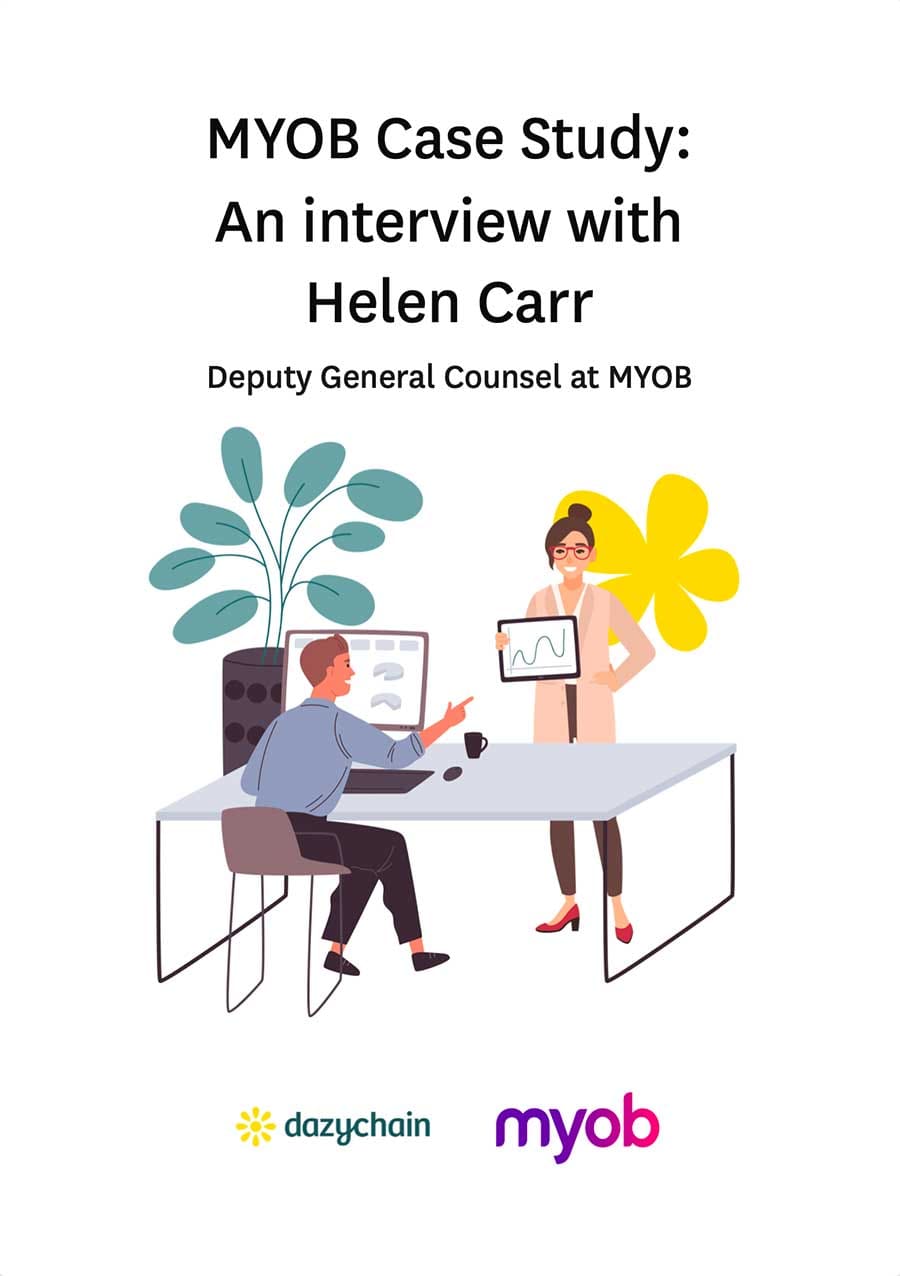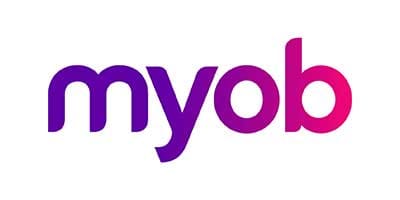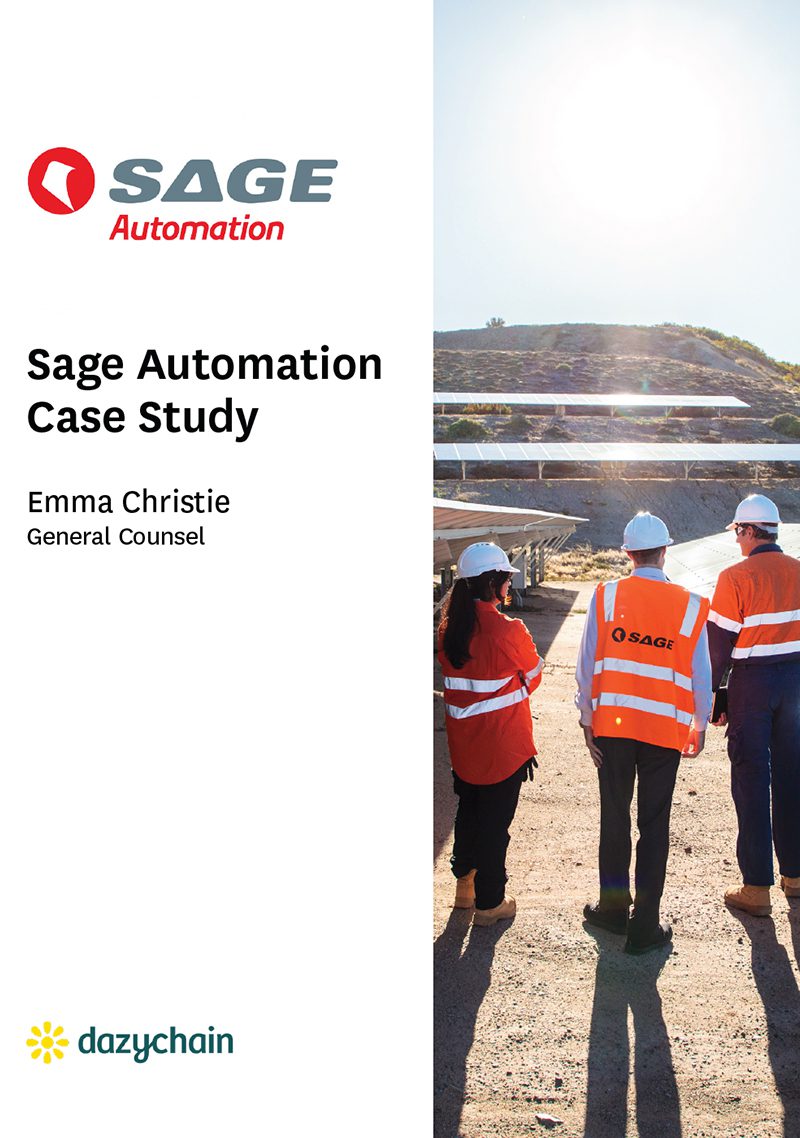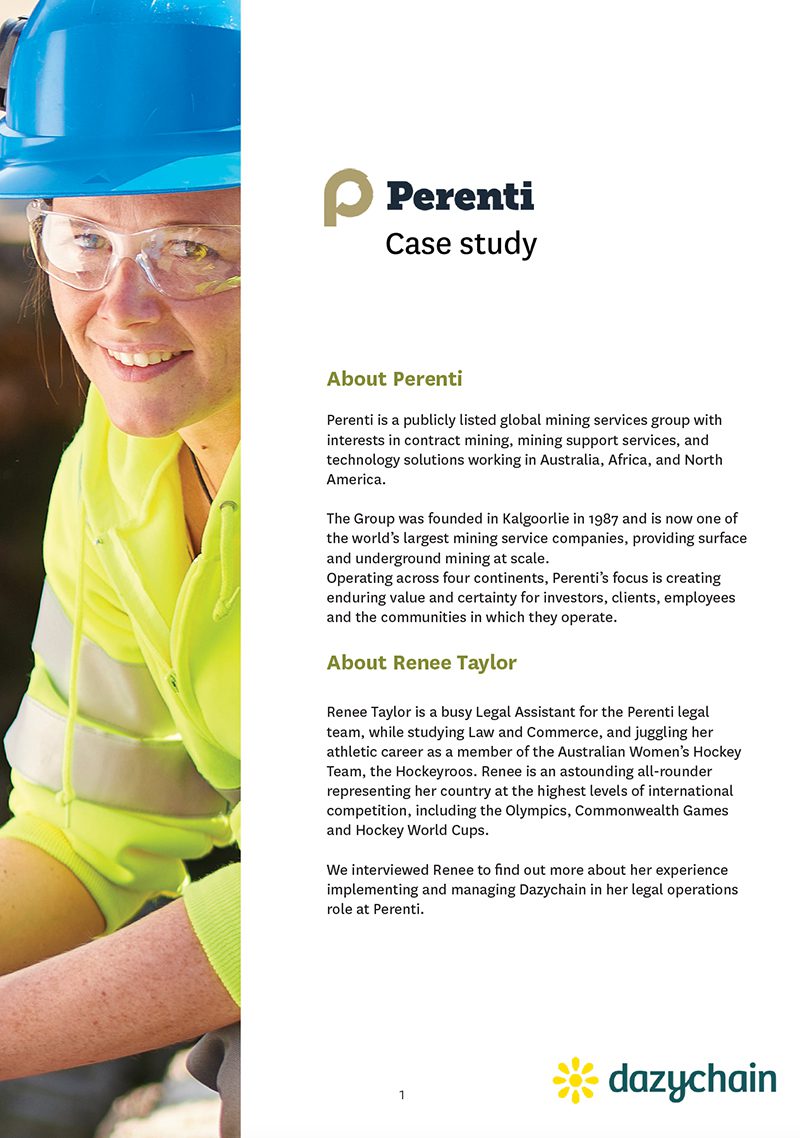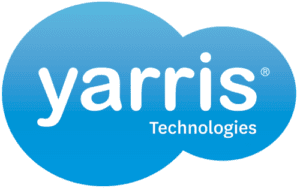An interview with Helen Carr, Deputy General Counsel at MYOB
Living in Dazychain
Let’s start with what I love about the system. The user interface. I find it easy to work and live in. Our previous matter management system was not user friendly and that created a point of friction. If the system isn’t user friendly, at the end of the day, people don’t want to update their matter management or filing. If the system is easier to use, it’s easier to stay on top of the filing and matter management. The ease of use, and the bright visual presentation of the user interface, makes it easier to look at for many hours a day.
Dashboards
The dashboards are really handy. I use them to get a feel for which areas of our business are sending in more legal requests, revealing which areas of the business might need a bit more legal support. Also, particularly with COVID and remote work, it gives me an extra tool to do that well-being check for our lawyers. In a couple of clicks, I can see how the team is tracking. Are they carrying a lot of work? Or are they getting behind on their matters? You can speak to people on a video call, but they present the face that they want to present on the day. Dazychain gives that extra insight, that extra prompt to check in and see how they’re going and if they need extra support. Are they behind on their filing or do they need help?
Dazychain is also good for our internal clients because it provides that easy check of which areas of the business need a lot of legal support. Do our legal resources align with those areas of the business that need the most support?
Our primary areas of focus in the dashboards include business division, matter type, and lawyer. We always have a fourth field, usually status, so we can filter the reports to look at our active and on hold matters and filter out the closed matters.
We also have some saved dashboards that divide matters by strategic impact and complexity, which is one of our measures that we collect when we set up the matter. We report to the CFO and we share those reports with her each month.
Dashboard’s role in business case for increased headcount
We’ve also used our dashboards with our CFO to create a business case to add additional headcount.
We identified some shifts in the type of legal matters that we were working on. We were able to show an uptick in the volume of matters, but also the complexity of matters that we were working on. We used that to advocate for additional headcount, which, in COVID times, was not the easiest thing to do. But we had the stats to back it up thanks to Dazychain. We copy the dashboards into our monthly report then speak to the issues: “Look at this particular area of the business, which the executive team have prioritized as a growth area. And look, this time last year we had five legal requests from them, then it was 10, then it was 15 and then it was 20. And that’s on top of our regular workload, which hasn’t changed. To serve the business well, we need to get additional legal resources to support that growth area of the business.” It was great to show real data to support what we felt was an increased workload.
Dashboards identify automation opportunities
We’ve also used the dashboard to identify automation opportunities and then to measure the success of those automation opportunities. We saw we were doing a lot of NDAs, which is not necessarily something in which a lawyer should have to be involved. So we made restricted access templates and help articles available throughout the business and then we were able to measure the impact of the templates on our legal team workflow.
We saw a dramatic drop-off of the number of legal requests for NDAs in the three months after we released the new templates. Our Dayzchain stats confirmed that the new NDA resources had allowed lawyers to shift their focus to more complex legal projects.
Using Dazychain day-to-day
Utilization varies between lawyers; some people use it daily, others jump into it, ideally at least once a week, just to update their matters. We use it as the matter repository of key records. We don’t file all emails or all working documents in it. We save key drafts and key documents to Dazychain to give an accurate representation of the matter. I always think of it as the ‘bus factor’; If I were hit by a bus, what would someone need to pick up and know what the key elements of the matter?
An example of that is on my projects list, I’ve got my active matters list that I live and breathe in. But then I also have other project lists and filters saved. So I have a filter for our enterprise business division. Enterprise is one of the key business areas that I support. When I’m on the phone to someone in Enterprise, I can just click that Enterprise button and it shows the active matters I’m working on for that business division. And I can say, “Hey, while I’ve got you. Just a reminder, I’m waiting to hear back from you on this.” And, “Hey, these other things are on my list and I haven’t done them yet.”
The team reaction to Dazychain
The lawyers use it in different ways and integrate it into their chosen way of working. The ones that really have become Dazychain advocates see that it is a way for them to track their own work and demonstrate that work to the team and the CFO. They can also demonstrate their work to the areas of the business they support.
I think everyone using the system needs to understand their ‘why’. There are some lawyers that struggle to see the why, because they do their daily task list elsewhere. They may use Trello, or paper and pen. They may tell me they are too busy to use a matter management system and my response is, “Let’s use the system to show that, because if you are too busy, we’ll get extra support. We’ll re-allocate work.” So if someone’s too busy to update Dazychain, I push them on that because we can use Dazychain as a health check, sense check, do we have the right legal resources?
Dazychain becomes a tool for a busy lawyer rather than just an administrative overhead.
Supervising teams
For people involved in supervising teams, it’s really useful. I found it really handy, particularly when I was acting General Counsel and supervising legal counsels day-to-day. Dazychain gave me a better sense of what they’re working on. It helped me make sure that our lawyers received the support they needed. And then our CFO likes it, particularly the charts and figures. Dazychain shows that her legal team is firing on all cylinders, focusing on what matters. Our CFO can then be an advocate for the legal team within the business.
Document migration
Now that we’ve migrated our historical records across to Dazychain, we have all of the legal team records dating back to the late nineties. The Dazychain search function is just a godsend. We no longer have to fire up our old matter management system, which had terrible search functionality. I can find things a lot more easily now that we’ve got more than 20 years’ worth of records in Dazychain.
The Dazychain team
Something else I love about Dazychain is the team, and the support that I receive. I can reach out to the Dazychain team and I feel like they really listen to the feedback we give about the system. We feel like what we say as customers matters, which is amazing.
I like Dazychain because it has the functionality that we need and not a whole lot of stuff that we don’t need. The user interface is relevant and configured to our needs. And then also as a price point for legal matter management, it becomes really appealing.
Interested in discussing Dazychain solutions?
An interview with Helen Carr, Deputy General Counsel at MYOB
Helen Carr
Deputy General Counsel
Living in Dazychain
Let’s start with what I love about the system. The user interface. I find it easy to work and live in. Our previous matter management system was not user friendly and that created a point of friction. If the system isn’t user friendly, at the end of the day, people don’t want to update their matter management or filing. If the system is easier to use, it’s easier to stay on top of the filing and matter management. The ease of use, and the bright visual presentation of the user interface, makes it easier to look at for many hours a day.
Dashboards
The dashboards are really handy. I use them to get a feel for which areas of our business are sending in more legal requests, revealing which areas of the business might need a bit more legal support. Also, particularly with COVID and remote work, it gives me an extra tool to do that well-being check for our lawyers. In a couple of clicks, I can see how the team is tracking. Are they carrying a lot of work? Or are they getting behind on their matters? You can speak to people on a video call, but they present the face that they want to present on the day. Dazychain gives that extra insight, that extra prompt to check in and see how they’re going and if they need extra support. Are they behind on their filing or do they need help?
Dazychain is also good for our internal clients because it provides that easy check of which areas of the business need a lot of legal support. Do our legal resources align with those areas of the business that need the most support?
Our primary areas of focus in the dashboards include business division, matter type, and lawyer. We always have a fourth field, usually status, so we can filter the reports to look at our active and on hold matters and filter out the closed matters.
We also have some saved dashboards that divide matters by strategic impact and complexity, which is one of our measures that we collect when we set up the matter. We report to the CFO and we share those reports with her each month.
Dashboard’s role in business case for increased headcount
We’ve also used our dashboards with our CFO to create a business case to add additional headcount.
We identified some shifts in the type of legal matters that we were working on. We were able to show an uptick in the volume of matters, but also the complexity of matters that we were working on. We used that to advocate for additional headcount, which, in COVID times, was not the easiest thing to do. But we had the stats to back it up thanks to Dazychain. We copy the dashboards into our monthly report then speak to the issues: “Look at this particular area of the business, which the executive team have prioritized as a growth area. And look, this time last year we had five legal requests from them, then it was 10, then it was 15 and then it was 20. And that’s on top of our regular workload, which hasn’t changed. To serve the business well, we need to get additional legal resources to support that growth area of the business.” It was great to show real data to support what we felt was an increased workload.
Dashboards identify automation opportunities
We’ve also used the dashboard to identify automation opportunities and then to measure the success of those automation opportunities. We saw we were doing a lot of NDAs, which is not necessarily something in which a lawyer should have to be involved. So we made restricted access templates and help articles available throughout the business and then we were able to measure the impact of the templates on our legal team workflow.
We saw a dramatic drop-off of the number of legal requests for NDAs in the three months after we released the new templates. Our Dayzchain stats confirmed that the new NDA resources had allowed lawyers to shift their focus to more complex legal projects.
Using Dazychain day-to-day
Utilization varies between lawyers; some people use it daily, others jump into it, ideally at least once a week, just to update their matters. We use it as the matter repository of key records. We don’t file all emails or all working documents in it. We save key drafts and key documents to Dazychain to give an accurate representation of the matter. I always think of it as the ‘bus factor’; If I were hit by a bus, what would someone need to pick up and know what the key elements of the matter?
An example of that is on my projects list, I’ve got my active matters list that I live and breathe in. But then I also have other project lists and filters saved. So I have a filter for our enterprise business division. Enterprise is one of the key business areas that I support. When I’m on the phone to someone in Enterprise, I can just click that Enterprise button and it shows the active matters I’m working on for that business division. And I can say, “Hey, while I’ve got you. Just a reminder, I’m waiting to hear back from you on this.” And, “Hey, these other things are on my list and I haven’t done them yet.”
The team reaction to Dazychain
The lawyers use it in different ways and integrate it into their chosen way of working. The ones that really have become Dazychain advocates see that it is a way for them to track their own work and demonstrate that work to the team and the CFO. They can also demonstrate their work to the areas of the business they support.
I think everyone using the system needs to understand their ‘why’. There are some lawyers that struggle to see the why, because they do their daily task list elsewhere. They may use Trello, or paper and pen. They may tell me they are too busy to use a matter management system and my response is, “Let’s use the system to show that, because if you are too busy, we’ll get extra support. We’ll re-allocate work.” So if someone’s too busy to update Dazychain, I push them on that because we can use Dazychain as a health check, sense check, do we have the right legal resources?
Dazychain becomes a tool for a busy lawyer rather than just an administrative overhead.
Supervising teams
For people involved in supervising teams, it’s really useful. I found it really handy, particularly when I was acting General Counsel and supervising legal counsels day-to-day. Dazychain gave me a better sense of what they’re working on. It helped me make sure that our lawyers received the support they needed. And then our CFO likes it, particularly the charts and figures. Dazychain shows that her legal team is firing on all cylinders, focusing on what matters. Our CFO can then be an advocate for the legal team within the business.
Document migration
Now that we’ve migrated our historical records across to Dazychain, we have all of the legal team records dating back to the late nineties. The Dazychain search function is just a godsend. We no longer have to fire up our old matter management system, which had terrible search functionality. I can find things a lot more easily now that we’ve got more than 20 years’ worth of records in Dazychain.
The Dazychain team
Something else I love about Dazychain is the team, and the support that I receive. I can reach out to the Dazychain team and I feel like they really listen to the feedback we give about the system. We feel like what we say as customers matters, which is amazing.
I like Dazychain because it has the functionality that we need and not a whole lot of stuff that we don’t need. The user interface is relevant and configured to our needs. And then also as a price point for legal matter management, it becomes really appealing.
